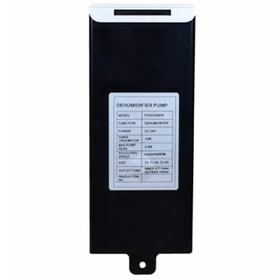
What's Causing Air Leakage and Moisture in Your Basement
Last Updated: Apr 11, 2025One of the unusual places that humans live is below the ground. It is something we have done since living in caves and hollows. From that time, we have gained a better understanding of creating healthier and more sustainable living spaces. Unfortunately, the concept of living in caves has stuck with us through the millennia as some primordial sense of safety.
Basements, however, are far from that truth. Understanding the science of basements, in simple terms, allows us to make healthier decisions on how we use and live in them. This article talks about ways to make things better and even livable in your basement.
Table of Contents
- Types of Basements
- Air Leakage
- Managing Moisture
- Bottom Line
Types of Basements
This article assumes your basement is full height, finished (in my particular case), and is usable space in a probable heating climate. If a basement is four feet or shorter in your geographic location, full of dirt, open to the outside air, or other strange things, then that is called a crawlspace, a dirt crawlspace, or even a dirt basement. We are not specifically talking about those creatures of a different stripe in this article.
Air Leakage
Understanding the air movement into the basement clarifies that there is value in air sealing the basement from the outside to reduce the inflow of dirty, dusty, moldy, and moist air from the outside. The typical entry places are around old windows (these are usually the last place people spend money on) and between the floor joists and rim beams.

Windows
The windows' most significant issue is not the windows themselves but around the window, between the window and the wall. This is where the bulk of air leakage occurs. If the house is more than 20 years old, most likely, there is just a piece of fiberglass insulation stuffed between these two building components. Insulation can slow down the thermal movement between inside and out, but it does nothing for air movement. As a low-cost solution, I recommend sealing up the old windows themselves with tape—such as aluminum tape, creating an air barrier tape between the operable window and the frame—or properly caulking around the trim between the wall and window to make it airtight. Try to find a zero VOC (volatile organic compound) caulking to use. This is the quick fix version.
The ideal version is to remove the trim, and add some spray foam, both an insulator and an air barrier, and reinstall the trim. There are now some low VOC foams out there, but not many. If you can’t tolerate foam due to chemical concerns, then tape up between the window and the wall directly with the air barrier tape of choice, and put the trim back on. Of course, if you have gone to all that trouble of tearing everything out, consider replacing the window. Energy efficiency grants and rebates are available in many locations.

Floor Joists / Rim Beam
The next important place where air sealing can be an issue is around the floor joists and rim beam. These are the wood parts of the house that sit directly on top of the concrete basement wall. What do I mean by this? Go to your laundry room or a furnace room in the basement, as these spaces can be unfinished, and look up at the top of the concrete wall where you see the wood. The floor joists run the width of your house, and the sill plate is the piece of wood that they sit on, which is lying on top of the concrete. The rim beam is the piece of wood you see on the outside of the floor joists.
All these components can leak air—lots of it. If there is no gasket (prelate 1970s) between the concrete and the sill plate, air moves between these components. Seal up the areas with caulking, spray foam, tape, or vapor barrier. The space between each floor joist, over the concrete wall, forms a “box,” with the sill plate on the bottom, the rim joist on the exterior, and the floor sheathing on top. Where these components all meet, there are numerous air leakage points. Air sealing these spaces is essential to help reduce air leakage in the home.
Not a do-it-yourselfer? Companies out there specialize in insulating and air sealing; they typically charge by the foot to do a job.
Managing Moisture
Now that the basement is air sealed, the next step is to dehumidify the space in the warmer months because moisture can condense in the basement when reaching the dew point. As the air cools (like on a cool basement floor), the volume becomes smaller. The ratio of water molecules in the air compared to the volume, therefore, increases. At 100% relative humidity, the two volumes are the same, and the water vapor turns into a liquid condensation. That can happen on your cold drinking glass in summer, your eyeglasses in winter walking into your home or your basement in humid weather.
Dehumidification
Dehumidifiers are a vital component of any healthy house that has a basement. Water vapor in the air can lead to mold growth, damage to contents and building materials, and impact occupant health. Very humid basements are a comfort issue as well, as the damp, smelly basement is the last place people wish to be in. Dehumidifiers remove moisture from the air and condense it into water. When purchasing a dehumidifier, consider an Energy Star rated unit, as it consumes the least amount of electricity compared to other similar models. The old brown dehumidifiers suck as much electricity as water and cost a considerable amount to operate.
The next important function is a built-in hygrometer. This allows you to set the relative humidity in the basement, and the dehumidifier will shut off when it reaches that set point. Ideal comfort for humans is between 30-50% relative humidity, generally. Above that humidity level is the ideal mold growth range (so you want to dehumidify below 50%). But below the 30% level is the ideal virus growth range, which is why we get sick in the winter, as it is too dry and the viruses take hold in our wet throats. Setting it within these parameters will ensure your dehumidifier is not working too hard as well.
Finally, a nice feature is a built-in hose bib. This allows you to hook a hose up to your dehumidifier and run a hose to a floor drain—which means you’ll never have to empty another bucket again.
Dehumidifiers are also sized for square footage, so please ensure the unit you purchase can remove the water from the space it is in. If you have many separate areas in a basement, it can be more useful to have more than one smaller unit taking care of basement sections. An alternative is to have oscillating fans at the far ends, moving the air towards the centrally located dehumidifier. Air conditioning does help reduce the need to dehumidify with a dehumidifier, but rarely does it mean you do not need one. Dehumidify during the cooling season or when the furnace is not running.
Dehumidifiers

Santa Fe Compact70 Dehumidifier - 4044110
Santa Fe
In Stock

Santa Fe UltraMD33 In-Wall Dehumidifier - 4044610
Santa Fe
Out of Stock

Innovative Dehumidifier IW25-5 In-Wall Dehumidifier
Innovative Dehumidifier
In Stock

AlorAir Sentinel HD55 Blue 113 Pint Commercial-Residential Dehumidifier
AlorAir
In Stock

Innovative Dehumidifier Condensate Pump for IW25-5 In-Wall Dehumidifier
Innovative Dehumidifier
In Stock

Santa Fe Small Hanging Kit - 4036695
Santa Fe
In Stock

Innovative Dehumidifier IW25-5 On-Wall Dehumidifier
Innovative Dehumidifier
In Stock

Santa Fe Condensate Pump Kit 4022220
Santa Fe
In Stock

Santa Fe ULTRA70 Whole Home Dehumidifier - 4044100
Santa Fe
In Stock

Santa Fe 10" Oval to Round Adapter - 4028399
Santa Fe
In Stock

Sumps
To reduce the potential of catastrophic water destroying your home, consider a sump hole/pit, which will create a buffer area between you and the rising groundwater. This is usually a hole dug in your mechanical room; the size and depth of a big garbage can go into the floor. A plastic bin goes in with holes in it, and a submersible pump pulls that water out of the hole and puts it outside somewhere safe. These are sealed lid units in radon country and very energy-efficient houses, so no soil gases are rising into the house. These are the best types of sumps.
Some 1970’s houses and older have a 12-inch sump hole. Unfortunately, that is not much protection assuming the sump pump is working. The deeper the hole you have, the better assurance you have that it will work when you need it. Remember the electricity goes out in severe weather, so check your pump during those times and the water level. Battery backups, water alarms, or other back-up power are things to consider, depending on how much water you have in the water table below your house.
Bottom Line
The more we can understand the basics of how our homes work, the more empowered we are to take better care of them and become able to avoid the potential concerns that come from a lack of understanding of our most important asset, our home.
In the next article, we will learn about how to finish the basement concerning walls, flooring, furniture, and activities in the basement, to ensure that the efforts carried out to this point yield a successfully healthy house.
Stephen Collette
Stephen Collette is a Building Biologist, Building Science Consultant, LEED Accredited Professional, and a Heritage Professional. Stephen is the owner of Your Healthy House and lives in Lakefield, ON with his wife and 2 daughters.
